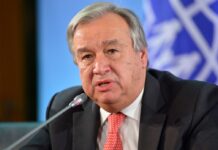“War never achieves its absolute because war is never an isolated act: war does not consist of a single short blow: and in war the result is never final.
Clausewitz, On War 1780-1831
War methods have transformed over the years from first- generation warfare to fifth, also known as hybrid warfare. Hybrid warfare is a military strategy which employs a blend of conventional and non-conventional warfare with political, irregular and emerging, alternating technologies being the most influential. It is the most dangerous form of warfare because it is hard to locate the targeted aspect as well as the direction of the incoming unleashed weapon.
Historically, Pakistan and India have been at war more than once and still continue with border skirmishes and minor conflicts involving trade and diplomacy, however, now India has shifted its strategy to hybrid warfare.
India made unlimited attempts to adversely affect the national security of Pakistan, however; Pakistan emerged victorious and defeated India through its strong course of counterattacks. Some tactics used by India to destabilize Pakistan’s security includes; evident insurgency through state-sponsored terrorism as in the Kulbhushan Yadav case, Lawfare; through abrogation of Article 370 of the Indian Constitution revoking the special status of Indian-Occupied Kashmir, the 2019 Pulwama- Balakot crisis, and the Indian Chronicles: India’s disinformation campaign.
India struck on several fronts, isolating Pakistan from the rest of the world. It has openly financed terrorism in Pakistan for many years. India’s state-sponsored terrorism was an attempt to paint Pakistan as a failing terrorist state on the worldwide stage. In recent years, India has been globally exposed as a sponsor of terrorism in Balochistan via Kulbhushan Yadav. An Indian agent who worked under the alias Hussain Mubarak Patel, who was apprehended at Pak-Iran border by border security forces in 2016, he confessed to being an Indian Navy officer recruited by the Indian intelligence agency, Research and Analysis Wing (RAW). He claimed that his purpose was to inflict insurgency in Balochistan. Separatist groups were funded financially and equipped militarily to fight against the government of Pakistan. These separatist groups include the Balochistan Liberation Army, the Baloch Republican Army and the Baloch Liberation Front. India completely denied any relation with the spy.
After facing defeat in creating anarchy in Pakistan, India again shifted towards the innocent Kashmiris and started to provoke them deliberately. Indian government abolished decades-old laws that gave a measure of autonomy to the disputed Muslim-majority region. Indian-Occupied Kashmir was stripped of its special status under Article 370 of the Indian Constitution and put under an infinite lockdown since 5 August 2019 with internet blackout, downgraded from a state to an union territory, and split into two. Article 370 had allowed the Indian-administered region jurisdiction to make its own laws in all matters except finance, defence, foreign affairs and communications.
Although these tactics used by India to destabilize the national security of Pakistan did not persist for long, they did damage it. It affected the national security of Pakistan politically, economically, militarily and socially. Politically it attempted to tarnish the image of the country internationally. Economically it added Pakistan to the FATF grey list in accusations of money laundering and terror financing. Militarily it started insurgencies and increased border conflicts. And in the social media, propaganda and disinformation at the global level were initiated. However, its effort stands null and void before the counter-efforts of Pakistan.
Ever since the Kargil incident in 1999, the Pulwama-Balakot crisis is the most serious military engagement between India and Pakistan. The Pulwama attack occurred in Indian-Occupied Kashmir, killing more than 40 personnel of the Indian Central Reserve Police Force. An attack was initiated by the Indian Air Force as they released payloads of bombs in Balakot, an area in KPK, on 26 February 2019. This led to an air combat between the Indian and Pakistani Air Forces on 27 February, which resulted in the loss of two Indian aircraft and the capture of Indian Wing Commander Abhinandan Varthaman by Pakistan.
“Essentially combat is an expression of hostile feelings. But in the large-scale combat that we call war hostile feelings often have become merely hostile intentions. At any rate, there are usually no hostile feelings between individuals. Yet such emotions can never be completely absent from war. Modern wars are seldom fought without hatred between nations; this serves as a more or less substitute for the hatred between individuals. Even when there is no natural hatred and no animosity to start with, the fighting itself will stir up hostile feelings: violence committed on superior orders will stir up the desire for revenge and retaliation against the perpetrator rather than against the powers that ordered the action. It is only human (or animal, if you like), but it is a fact.”
(Carl von Clausewitz)
Indian Chronicle is a very recent episode of India’s hybrid warfare against Pakistan. The Indian state intelligence agencies carried out a disinformation campaign against Pakistan for 15 years. There was fake news development against Pakistan in more than 116 countries and 9 regions of the world. It hijacked definite international organizations such as the UN and EU parliament and its members. Around 750 fake news outlets and more than 550 domain names, which not only created an eco-cycle around Indian information operations, which were then amplified by the Asian News International (ANI); fake news agencies that created this mass perception against Pakistan. Its purpose was to distort Pakistan’s image internationally through registration of fake domains. Even the deceased were resurrected for anti-Pakistan statements.
Although these tactics used by India to destabilize the national security of Pakistan did not persist for long, they did damage it. It affected the national security of Pakistan politically, economically, militarily and socially. Politically it attempted to tarnish the image of the country internationally. Economically it added Pakistan to the FATF grey list in accusations of money laundering and terror financing. Militarily it started insurgencies and increased border conflicts. And in the social media, propaganda and disinformation at the global level were initiated. However, its effort stands null and void before the counter-efforts of Pakistan.























Cograts raniaa! keep at least 1/2 of pakistan from 1947. who knows kasabs, modis or sindhis, or pasthuns further….
“Tand Nahin, Mulk Da Sara Tana Bana Hee Wigadya Hoya Hai” (Not a thread, the balance of entire cloth i.e. the nation, is messed up). Khuda Khair Kare. 🤔